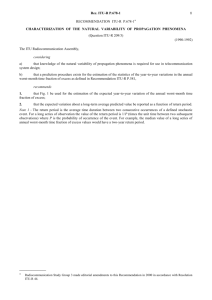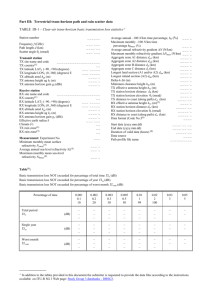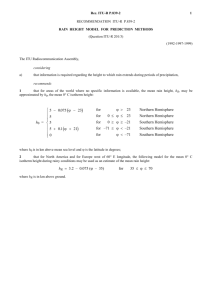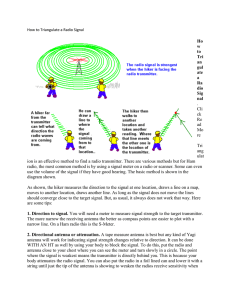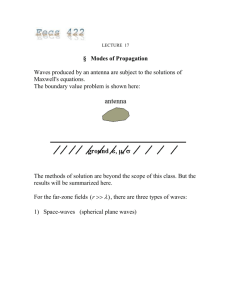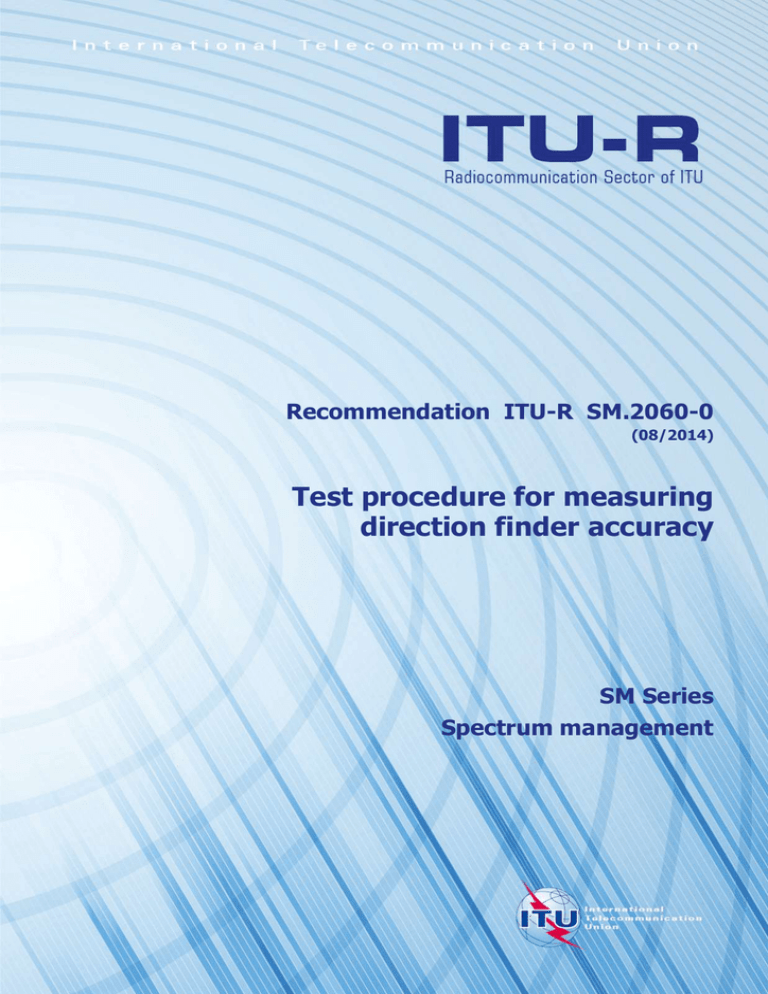
Recommendation ITU-R SM.2060-0
(08/2014)
Test procedure for measuring
direction finder accuracy
SM Series
Spectrum management
ii
Rec. ITU-R SM.2060-0
Foreword
The role of the Radiocommunication Sector is to ensure the rational, equitable, efficient and economical use of the radiofrequency spectrum by all radiocommunication services, including satellite services, and carry out studies without limit
of frequency range on the basis of which Recommendations are adopted.
The regulatory and policy functions of the Radiocommunication Sector are performed by World and Regional
Radiocommunication Conferences and Radiocommunication Assemblies supported by Study Groups.
Policy on Intellectual Property Right (IPR)
ITU-R policy on IPR is described in the Common Patent Policy for ITU-T/ITU-R/ISO/IEC referenced in Annex 1 of
Resolution ITU-R 1. Forms to be used for the submission of patent statements and licensing declarations by patent holders
are available from http://www.itu.int/ITU-R/go/patents/en where the Guidelines for Implementation of the Common
Patent Policy for ITU-T/ITU-R/ISO/IEC and the ITU-R patent information database can also be found.
Series of ITU-R Recommendations
(Also available online at http://www.itu.int/publ/R-REC/en)
Title
Series
BO
BR
BS
BT
F
M
P
RA
RS
S
SA
SF
SM
SNG
TF
V
Satellite delivery
Recording for production, archival and play-out; film for television
Broadcasting service (sound)
Broadcasting service (television)
Fixed service
Mobile, radiodetermination, amateur and related satellite services
Radiowave propagation
Radio astronomy
Remote sensing systems
Fixed-satellite service
Space applications and meteorology
Frequency sharing and coordination between fixed-satellite and fixed service systems
Spectrum management
Satellite news gathering
Time signals and frequency standards emissions
Vocabulary and related subjects
Note: This ITU-R Recommendation was approved in English under the procedure detailed in Resolution ITU-R 1.
Electronic Publication
Geneva, 2014
ITU 2014
All rights reserved. No part of this publication may be reproduced, by any means whatsoever, without written permission of ITU.
Rec. ITU-R SM.2060-0
1
RECOMMENDATION ITU-R SM.2060-0*
Test procedure for measuring direction finder accuracy
(2014)
Scope
The accuracy of direction finding systems is an important consideration to regulatory authorities and others
who have to locate signals. It is often difficult to compare different systems due to a number of factors, such
as the particular system basic design architecture, typical use/purpose, size requirements, installation
requirements, and other issues. In order to facilitate some basic comparisons between different direction
finding (DF) systems, this Recommendation provides some guidance on standard methods of testing DF
accuracy and reporting results.
Keywords
DF accuracy, measurement, test site, open-air-test-site, OATS
Related ITU Recommendations, Reports
Recommendation ITU-R SM.2061.
Report ITU-R SM.2354.
NOTE – In every case the latest edition of the Recommendation/Report in force should be used.
The ITU Radiocommunication Assembly,
considering
a)
that ITU-R has published the typical specifications for direction finding (DF) accuracy in the
ITU Handbook on Spectrum Monitoring (Edition 2011);
b)
that the Handbook refers to Report ITU-R SM.2125 – Parameters of and measurement
procedures on H/V/UHF monitoring receivers and stations, which defines the DF accuracy and
provides some relevant test procedures;
c)
that the specification of DF accuracy strongly depends on the test procedures applied;
d)
that the DF accuracy parameter may have direct influence on the suitability of a direction
finder to fulfil certain monitoring tasks such as mobile or fixed use or usefulness to measure digital
wideband signals, especially when used in typical operating environments;
e)
that a defined set of test procedures for DF accuracy must be independent of the DF design;
f)
that a well-defined set of test procedures for DF accuracy, if adopted by all manufacturers of
DF intended for civil radio monitoring, will have the advantage for the users of such DF, that an easier
and more objective assessment of products from different manufacturers is possible;
g)
that performance data in specifications of DF equipment usually show the performance under
ideal test conditions or one specific condition;
h)
that for considering DF accuracy in multi-path environment, DF accuracy will not be defined,
instead DF immunity against multi-path propagation will be addressed according to the test procedure
defined in Recommendation ITU-R SM.2061-0;
*
Radiocommunication Study Group 1 made editorial amendments to this Recommendation in 2015 in
accordance with Resolution ITU-R 1.
2
Rec. ITU-R SM.2060-0
i)
that for considering DF accuracy under operational conditions, the test procedure defined in
Report ITU-R SM.2125 should be used,
recommends
1
that the test procedure in Annex 1 should be used to determine and report the DF accuracy.
2
that for each DF accuracy performance specification given in the specifications of the DF
system, the test procedure and test conditions should be specified.
Annex 1
1
Introduction
This Recommendation proposes a general test procedure that can be used to evaluate the DF accuracy
of radio direction-finding systems. The aim of this document is to provide a definition of DF accuracy
and a standard method that can be used to conduct testing, so that administrations can have some
basis for comparison of DF systems from different manufacturers, based on their requirements.
The DF accuracy is defined as the root mean square (RMS) value of the difference between the true
azimuth and the displayed bearing.
The method proposed here is used to determine the “system accuracy” in a defined set of test
conditions simulated on a test range under ideal/controlled propagation conditions, and can be used,
for example, for calibration purposes.
Considering the objective to simplify the measurement, effects of modulation type (including phase
and time variant signals), signal duty cycle, bandwidth, signal polarization, and signal duration, noise
and other signal and DF quality parameters (e.g. DF sensitivity), the integration time of the DF as
well as external uncontrollable conditions such as multi-wave/multipath propagation conditions, are
intentionally ignored to reduce the complexity of the tests procedure and the time duration of the
measurements.
For DC accuracy tests, the DF system can be placed in an open-air-test-site (OATS), which is
addressed in § 2.1, but a DF system can be also placed on an anechoic chamber, which is addressed
in § 2.8.
While this document aims to establish a basic guide for standard test procedures, a further discussion
of DF accuracy considerations can be found in the ITU Handbook on Spectrum Monitoring (Edition
2011), Chapter 3.4 and in Report ITU-R SM.2125 – Parameters of and measurement procedures on
H/V/UHF monitoring receivers and stations.
The remainder of this document describes this test procedure in more detail, in order to establish a
common guidance for conducting this test across different manufacturers.
2
Definition of test conditions
2.1
General considerations for OATS
A system can be placed on an OATS, in an electromagnetically clean environment without (or
reduced) reflections or structures that could provide scattering, resonances or re-radiation, and tested
with strong signals.
Rec. ITU-R SM.2060-0
3
OATS definition can be found in a number of standards documents such as ANSI C63.7, CISPR or
EN55 022. The OATS is considered as line-of sight with no interference signal, no reflection and farfield (Fraunhofer Region)1 condition.
The required wave reflection characteristics are described in assessing the size needed for a good
reflecting surface by using the theory of Fresnel Zones. The following conditions should be
considered for the selection of general OATS. It should:
–
be clear of buildings;
–
have no metallic surfaces nearby;
–
have no roads nearby that might lead to interference from vehicles;
–
be at a sufficient distance from any interfering transmitter (broadcast, mobile telephony,
airport, etc.);
–
be at a sufficient distance from noise sources such as high-voltage power lines, telephone
lines, etc.
Such an environment can be found in a large open field without obstacles.
The measurement setup for testing a direction finding station on an OATS is shown in Fig. 1.
Measurements in such an uncluttered environment serve to determine the “system accuracy” of the
DF system under ideal/controlled propagation conditions. This “system accuracy” is usually not a
measure of how a DF system will perform in actual operational conditions. It should be noted that
most DF systems perform well in the controlled environment of a laboratory or test bed when strong
test signals are used, but with this method it will be possible to perform comparisons between different
DF systems. “System accuracy” tests are usually included in data sheets and can be used as reference
to compare with “operational accuracy” tests for site acceptance tests, and to compare with “DF
immunity” tests against multi-path for controlled multi-path conditions.
For this “system accuracy” test under ideal conditions, the DF accuracy of the direction finder is
measured by using a test transmitter located in the surroundings of the DF antenna, in an environment
with very low reflections. The test arrangement must permit changing the azimuth of the transmitter’s
test antenna in defined steps to cover the full bearing range of 360°. An alternate arrangement may
place the DF system on a turntable with a fixed transmitter at a certain azimuth. In this arrangement,
the DF system is rotated and the amount of rotation is used with the bearing indication to calculate
the bearing error.
1
More information about the far-field (as well as other aspects of electromagnetic fields relevant to this work)
can be found in Recommendation ITU-R BS.1698, in particular § 2.1.2.
4
Rec. ITU-R SM.2060-0
FIGURE 1
DF accuracy measurement setup for a direction finding station on OATS
Transmit antennas (Tx)
DF antennas (Rx)
Amplifier and
switch
Turn table
Signal
generator
PC control system
DF receiver and
processor
SM.2060-01
2.2
Test frequency selection
When selecting test frequencies, careful consideration must be given to the selection of test
frequencies. The electromagnetic environment of the OATS should be determined before testing.
Some frequencies should be avoided because of possible interference issues from signals authorized
in the general area, and there may be certain frequencies for which the propagation medium or
multipath effects can lead to DF errors. Frequencies with impairments caused by external effects
should be excluded from the test.2 In addition, careful consideration must be given to existing
uncontrollable multipath reflections on the test site. More specifically, on an otherwise clear open test
site, the effects of reflections from the ground between the transmitting and the receiving antennas
depend mainly on the test frequency and antenna heights (both the DF antenna height above ground
as well as the transmitting antenna height). The possible reflections need to be considered in selecting
test frequencies. Usually, antenna heights and distances are restricted at an OATS due to available
land or other site limitations, and this can lead to constructive or destructive interference of the two
path propagation (line-of-sight and ground reflected) between the transmitting antenna and the DF
antenna. This effect should be minimized by careful selection of test frequencies, antenna heights and
test distances.
Figure 2 illustrates an example of the loss between a transmitter (Tx) and a receiver (Rx) from
100 MHz to 1 200 MHz at an OATS and shows occurrence of constructive and destructive
interference.
2
If there is an interference signal on the test frequency which is 6 dB higher than the noise floor, the test
frequency can be changed to a new one but within 5 MHz around the original frequency to avoid the
interference.
Rec. ITU-R SM.2060-0
5
FIGURE 2
Example of the loss between Tx and Rx at OATS (from 100 MHz to 1 200 MHz)
Loss between Tx and Rx
10
Constructive
Loss (dB)
20
30
40
50
Destructive
60
100
200
300
400
500
600
700
800
900
1 000 1 100 1 200
Frequency (MHz)
SM.2060-02
In conclusion, it is not realistic to test on an OATS without some multipath for “system accuracy”
tests. Therefore, ground effects and other anomalies should be considered or mitigated, and
frequencies affected by test site conditions due to destructive multipath or strong external interference
sources should be determined and avoided when measuring DF accuracy.
It should be noted that the phase response of the DF antenna is also affected by the constructive and
destructive interference which must also be considered for selecting the test frequencies.
Once the characteristics of the OATS are known, test frequencies can be selected across the frequency
range of operation of the DF system. For a DF antenna in the range 30 MHz to 3 000 MHz at least 20
frequency points are required, which are selected on the basis of logarithmic scale of frequency
response, evenly distributed across the entire range. The same applies for an LF or HF directionfinder operating below 30 MHz. For narrower ranges the number of frequency points may be reduced
systematically. Tests on additional frequencies may be requested to be added by administrations to
meet their special requirements.
In case a finer frequency spacing is required, the following frequency intervals are recommended:
–
Frequency spacing in the range 30 MHz to 50 MHz: approx. 5 MHz;
–
Frequency spacing in the range 50 MHz to 150 MHz: approx. 10 MHz;
–
Frequency spacing in the range 150 MHz to 500 MHz: approx. 20 MHz;
–
Frequency spacing in the range 500 MHz to 3 000 MHz: approx. 50 MHz.
2.3
Test equipment settings
A signal generator capable of a single carrier un-modulated signal and a set of transmitting antennas
for the tested frequency band are needed for transmitting test signals. Usually the set of antennas
includes one for each band (HF, VHF, UHF, etc.) using directional antennas to mitigate multi-path
radiation.
The height of the transmit antenna should be similar to the height of the DF antenna to ensure that
the elevation angle of arrival of the test signal at the DF antenna does not degrade the DF accuracy.
For VHF and above, a minimum height above ground of half of the wavelength of the lowest test
frequency is recommended to ensure that the ground reflection does not affect the DF accuracy.
6
Rec. ITU-R SM.2060-0
A local area network switch and client computer may also be needed to automatically control the
signal generator and the DF system so that a predefined test frequency range can be swept for DF. A
turntable can be used to mount the DF system on to aid in changing the azimuth angle.
The signal level of the transmitter should be adjusted to make sure that the field strength of the
transmitted signal, as received at the DF antenna has a SNR of 20 dB.
The DF bandwidth should be set to a value around 10 kHz to 15 kHz for the narrowband un-modulated
signal (if the DF system does not support this setting, choose the nearest value which is higher than
the default parameter value). Other settings should be the optimal settings for the DF system. All
relevant settings should be specified in the data sheet.
Finally, all test equipment (including transmitter, transmitting antennas and turntable) should be
calibrated periodically.
2.4
Test site selection
If it is open field, the test site for the DF accuracy must be relatively flat with no RF scattering
obstacles (buildings, fences, light/power poles, overhead lines, etc.) and with no manmade noise
sources (such as electrical noise from power generators, power transmission lines, or similar sources).
Once the test site is selected, erect the DF antenna at the centre of the field, and layout the test azimuth
angle 360 degrees around the DF antenna.
The distance between transmitting antenna and DF antenna must satisfy contradicting requirements.
On the one hand it must fulfil far-field conditions which call for a long distance, on the other hand a
short distance would be helpful in order to reduce multi-path propagation and use lower power
transmitting equipment. In the VHF/UHF range, the distance between the test transmitting antenna
and the DF antenna should be the greater of 10 times the wavelength of the lowest test frequency or
the distance calculated by means of the formula below.
R
2D 2
where:
R:
D:
λ:
2.5
range length (separation distance between transmit and receive antennas)
(metres)
aperture of antenna under test (for circular antenna arrays this is the diameter)
(metres)
wavelength of the test frequency (metres)
Test azimuth angle layout
The test azimuth angles must include angles from all four quadrants of the 360° circle (assuming a
circularly disposed array DF antenna). If a directional antenna is used for DF, the angles have to be
inside the main lobe of the radiation pattern. A statistically acceptable sample of test azimuth angles
(a minimum of 16) should be selected for computations.
2.6
Test data collection
The test can be set up with the signal generator swept across the frequency range of the directionfinder using a defined set of frequencies for each test azimuth angle as described earlier. All the test
data should be recorded. The test data result can be saved in a file and can be used later for the
statistical calculation.
Rec. ITU-R SM.2060-0
2.7
7
Test data evaluation
First, the measured azimuth error is calculated:
θ ( F ,) (θ mes – θ theo )
where:
θmes:
θtheo:
angle measured at the frequency and the selected azimuth (degrees)
theoretical angle of the selected azimuth (degrees)
Compute the result of DF accuracy by calculating a quadratic average of all the values on all measured
frequencies and the selected azimuths:
θ( F ,) 2
θ
θ:
θ(F,θ):
N:
F
N
DF accuracy (degrees RMS)
calculated azimuth error at one frequency and one azimuth (degrees)
number of measurement samples for all azimuths and frequencies
It is possible to compensate for the error due to installation bias of the DF antenna by taking into
account the average bias from all measurements as follows:
θ( F ,θ)
θ θ –
F
N
Example for a specification in a data sheet of “system accuracy” in ideal OATS case, for an antenna
covering the full range from 30 MHz to 3 000 MHz3:
DF accuracy: ≤ 2.5° RMS (30 MHz to 3 000 MHz).
TABLE 1
Sample test data table
Signal modulation _______________Signal polarization ________
True
3
Index
Azimuth
1
1°
2
28°
3
77°
16
354°
Frequency 1
DF
Frequency 2
DF
Frequency 3
DF
Frequency 4
DF
Normally the specification will cover the full operating range of the antenna.
Frequency M
DF
8
Rec. ITU-R SM.2060-0
Note that the is bearing error for each measurement. It is calculated as the difference between the
true azimuth and the displayed bearing on the DF equipment.
2.8
General considerations for anechoic chambers
If a measurement setup in an anechoic chamber complies with the prerequisites described for ideal
measurement on OATS, the DF accuracy results for “system accuracy” in ideal conditions can be
considered equivalent to OATS tests. It should be noted that “system accuracy” measurements in
anechoic chambers are usually possible only for UHF or higher frequencies due to the limited size
and the reflection properties of the anechoic chamber.
2.9
Antenna polarization
The polarization of the test transmitter antenna should match the polarization of the DF antenna. All
main polarization angles supported by the DF antenna should be tested. The polarization used should
be mentioned in the test report.
2.10
Additional considerations for HF DF measurements
The measurement of the HF DF accuracy faces some further constraints:
–
HF signal wavelengths require significant physical distances between transmitters and
receivers in order to ensure far-field conditions;
–
The level of atmospheric noise is not controllable (depends on the solar activity, daytime or
night time, and other variables). It is often significantly higher than the DF system noise so
that meeting the requirement of a minimum SNR of 20 dB may be difficult to ensure.
Measurements of HF DF accuracy should generally be the same as for VHF/UHF DF accuracy, except
that:
–
the transmitter could be a real broadcast transmitter with known characteristics (azimuth,
level);
–
an HF transmitter in a vehicle at a known position in the far-field could be used;
–
the number of azimuths tested may be limited by geography or other factors;
–
the type of tests described here consider only ground wave DF accuracy for HF direction
finding systems, and other types of testing would be needed to evaluate skywave signals.
3
Special considerations for mobile DF systems
3.1
Considerations for mast and roof mounted mobile configurations
In addition to the test procedure described for the fixed system, testing of mobile systems should
include additional tests and considerations. The DF antenna is mounted on the rooftop of the vehicle,
therefore the DF collection would include the configuration where the DF antenna is in the mastdown position and mast-up position (this assumes that the DF system is expected to operate in mobile
as well as stationary or semi-mobile mode).
The preferred method to ensure good DF performance after installation is to perform DF
characterization on an automated turn-table. This characterization procedure is used to overcome
coupling effects from additional antennas, mechanical structures and other scatter objects on the
rooftop of the vehicle. Figure 3 shows a typical practical setup for an automated turntable and test
transmitter. However, these characterization and DF verification tests could be a costly exercise if
such infrastructure is not available, the alternative will be next discussed.
Rec. ITU-R SM.2060-0
9
FIGURE 3
DF measurement using an automated turntable setup
Transmit antenna (Tx)
DF antenna (Rx)
Amplifier and
switch
Signal
generator
Turn table
PC control system
DF receiver
and processor
SM.2060-03
The practical alternative to verify DF system accuracy is to use the same procedure as for the fixed
system, except the mobile system needs to be parked in an open field with line-of-sight to the target
transmitters (also ensuring that the sources are in the far field). The test can be carried out in a
mast-down and mast-up position indicated in Fig. 4. Rather than moving test transmitter(s) from
location to location as in the case of fixed station testing, it may be preferable to leave the test
transmitter(s) in fixed location and instead reorient the DF system. This requires accurate
determination of the orientation of the mobile DF station relative to true north or relative to the
bearing to the test transmitter. If a magnetic compass is used, the angle variation from the true north
line of bearing also needs to be considered. Pre markings on the ground could assist as shown in
Fig. 5.
FIGURE 4
Mast and roof mounted mobile configurations
SM.2060-04
10
Rec. ITU-R SM.2060-0
FIGURE 5
Typical open field test setup with pre-markings
DF antenna (Rx)
Transmit antenna (Tx)
Amplifier and
switch
Signal
generator
Test field and angle
markings on ground
DF receiver
and processor
PC control system
SM.2060-05
3.2
Power source installation considerations
The ITU-R Handbook on Spectrum Monitoring describes power supply of mobile station in
§ 2.4.2.2.4. A variety of power sources for equipment in mobile stations are commercially available,
including batteries or secondary cells, inverters, generating sets and mains supply. A well-equipped
mobile station will use at least two sources for redundancy and careful consideration should be given
to proper EMC design.4
In the HF band, the petrol engine from the vehicle itself will cause interferences. Tests in anechoic
chambers have shown that the typical petrol engine will produce most of the interference in the HF
band, as shown in Fig. 6. There is a lot of interference spread in the HF band, but the noise floor does
not increase dramatically.
FIGURE 6
Radio noise from typical petrol engine
80
Level (dBm V/m)
70
60
50
40
30
20
10
0
3M
4M
5M
6M 7M 8M
10M
20M
30M
Frequency (Hz)
MES 0312-15_red PK
MES 0312-15 pre
SM.2060-06
4
It is very important to test the EMC characteristics of the mobile DF systems before testing the DF accuracy,
to make sure that the DF system meets the electromagnetic compatibility design requirements.
Rec. ITU-R SM.2060-0
11
Radio noise from typical engine-driven generators and inverters with auxiliary battery configuration
also needs to be considered carefully. Tests in anechoic chambers have also shown the radio noise
from this kind of power configuration (see Fig. 7). There the interference level in the HF band is even
higher than that of the petrol engine, and the noise floor increases dramatically.
FIGURE 7
Radio noise from typical engine-driven generator
80
Level (dBm V/m)
70
60
50
40
30
20
10
0
3M
4M
5M
6M 7M 8M
10M
20M
30M
Frequency (Hz)
MES 0313-15_red PK
MES 0313-15 pre
SM.2060-07
It has to be ensured that the required 20 dB S/N is achieved for all tested frequencies even in the
presence of the pre-recorded interference from the vehicle. It should be avoided to measure on the
peaks of interference (examples marked with red x in Fig. 7) by carefully selecting the exact test
frequencies.
4
Alternative measurement method using a multipath simulation
In the absence of an ideal OATS, especially for the HF frequency range, the “DF instrument accuracy”
may also be measured by connecting a highly specialized test signal generator that can simulate
different angles of arrival as well as ground reflections, directly to the DF receiver input. This method
would, however, not include the influences of the real DF antenna and the DF accuracy results
measured with this setup may not necessarily be comparable to the results achieved with a real OATS
as described in this Recommendation, unless the DF antenna is also modelled correctly in the test
system5.
5
For more information see Report ITU-R SM.2354-0.


